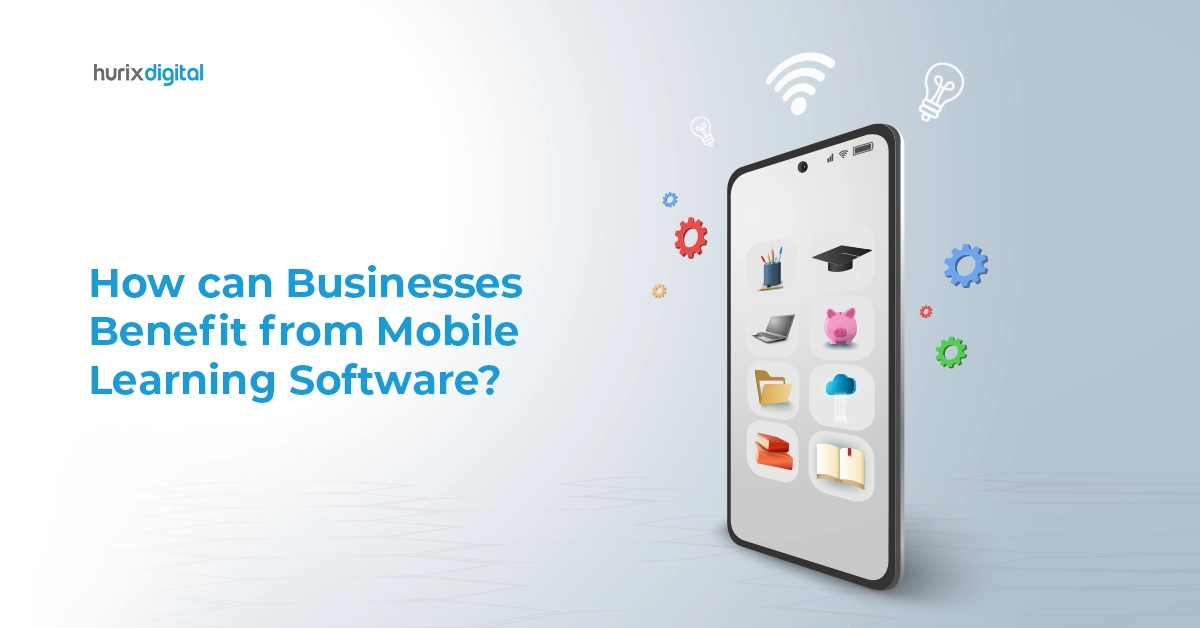
How Can Businesses Benefit from Mobile Learning Software?
Summary
This article provides a brief overview of what mLearning tools are and how businesses can benefit from them.
If you are keen on learning new skills, you have probably used one of the many mobile learning software available today. It is a fact that mLearning tools make it drastically simple and easy to access new knowledge and skills by being available on portable, handheld devices.
Perhaps this reason is marking tremendous growth for mobile learning platforms today – whether it be schools or businesses. The news is that the market for mobile learning software is growing at a CAGR of 28.5%.
So, how are businesses benefiting from mLearning tools? Let’s find out.
Table of Contents:
- What Is Mobile Learning Software?
- 8 Key Benefits of Mobile Learning Platforms for Businesses
- Wrapping Up
What Is Mobile Learning Software?
Mobile learning, or mLearning, allows users to access coursework or material through mobile devices, like phones or tablets. The biggest advantage of mLearning tools is that they provide access to courses at the point of need, making it extremely convenient for learners to participate in the lesson.
The primary focus of mobile learning platforms is learner mobility. The platforms can be accessed on the go and do not require the learner to be stationary or situated at a specific location. These platforms come equipped with options for text-to-speech, enabling all learners to consume knowledge whether they have visual impairments or preferences toward auditory learning methods.
8 Key Benefits of Mobile Learning Platforms for Businesses
Learning and development strategies can benefit significantly from leveraging the functionalities of mLearning tools. For example, such technologies are the best options to increase learner engagement. Research shows that mLearning tools can improve retention by 55%. Let’s understand more benefits of this training method for businesses.
1. High Penetration and Accessibility
It is impossible to imagine a workforce that does not have access to a mobile phone. Every employee, staff member, or professional under a company’s payroll owns a mobile phone.
Deploying company training using mobile learning software enables a high degree of penetration into the workforce – everybody can access it using either an employee app or a portal. It also helps to improve accessibility to the training modules.
2. Cost Effective
One of the chief advantages of mobile learning platforms is that they allow businesses to optimize their training costs. Employees are no longer required to be physically present for training, eliminating the need to put off work (and increase the cost of productivity) to enroll in mandatory training.
mLearning tools make it possible for employees to complete the training in their own time.
Additionally, for the company, these tools help reduce the distribution costs of the training.
Also Read: Benefits & Use Cases of Mobile Learning in Enterprise Training
3. Training Flexibility
The convenience and flexibility that mobile learning software brings to the table is unmatched. Employees can access the courseware from anywhere and at any time. A LinkedIn report shows that employees used the following times to access mobile training:
- 32% during business travel
- 26% at home
- 24% while commuting
- 18% during work or at the office
4. Easy Onboarding
Each recruit must undergo a certain level of training and familiarization with how the company works. By incorporating an onboarding training session delivered through mobile phones, it is possible to simplify the onboarding experience for new hires and make it simpler for their peers to assimilate their new colleagues into the workflow.
It incorporates a seamless journey from getting hired to getting down to work.
5. Immediate Feedback
Handheld devices are always on person – people always carry them around, even when changing the rooms they are sitting in. Things being so, training delivered over handheld devices provides prompt feedback on the candidate’s performance.
They don’t have to log in to their emails or access VPN-protected company dashboards to know how they performed on a training module. One notification is enough to remind them their feedback is ready to be accessed on their mobile phone.
6. Workflow-Integrated Delivery
Traditional methods of delivering training to employees involved putting all work on hold while they used their laptops to access the training module. Not only was this counterproductive, but it disturbed the entire workflow.
Using mobile phones to deliver training, it is possible to have employees continue with their work as they listen to the training content and engage with the module only when required.
7. Higher Engagement and Interaction with Millennial and Gen-Z Employees
As the world progresses, Gen-X and Boomer employees will retire. Workplaces are increasingly populated by Millennials and Gen-Zs – a demographic that is not only tech-savvy but extremely sensitive about customizable experiences.
Companies can deliver customized, personalized employee training to each individual using mobile-based training methods. It significantly improves engagement in Gen-Z and Millennial demographics, allowing them to take the training on their terms.
8. Higher Completion Rate
According to studies, employees accessing training material using smartphones completed the training 45% faster than those using laptops. This proves that incorporating mLearning tools into the training ecosystem has a huge impact on training completion rates.
This may be because of psychological factors, like not wanting to open the laptop again after shutting it down, whereas a mobile phone always remains on and available.
Also Read: Advantages of Mobile Learning Solutions for L&D Teams
Wrapping Up
Needless to say, businesses wishing to improve their outcomes from employee training ought to leverage one of the best mobile learning software available in the market today. To aid businesses towards that goal, Hurix Digital provides a plethora of technological and digital solutions that help businesses set up the infrastructure needed to apply this training method.
With Hurix Digital, businesses can implement future-proof learning technology on-premises and design exemplary learning experiences for their employees. To understand the scope of services Hurix Digital can provide, reach out today.

Vice President – Digital Content Transformation. He is PMP, CSM, and CPACC certified and has 20+ years of experience in Project Management, Delivery Management, and managing the Offshore Development Centre (ODC).







